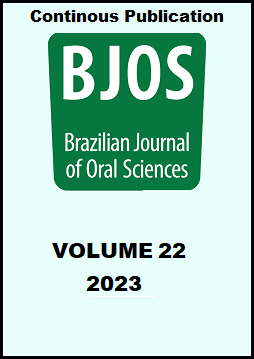Abstract
Aim: To evaluate the bottom/top hardness ratio (B/T) and the dentin bonding stability of conventional and bulk-fill resin composites in high c-factor preparations. Methods: Regular conventional (Tetric N-Ceram – TNC, and Polofil Supra – PFS), regular bulk-fill (Tetric N-Ceram Bulk fill – TBF, and Admira Fusion X-tra – AFX), and low viscosity bulk-fill resin composites (Tetric N-flow – TNF, and X-tra Base – XTB) were used to restore 180 dentin conical preparations. The specimens were randomly distributed in 12 groups (n = 15) according to the resin composites and storage time-points (24 h and six months) tested. After 24 h storage, all specimens were subjected to the bottom/top hardness ratio analysis. Then, the push-out bond strength test was performed in half of the specimens and the other half were maintained for six months on water storage before testing. The failure modes were analyzed in a stereomicroscopic. The data were analyzed statistically using one- and two-way ANOVA and Tukey post-test (p <0.05). Results: There were no statistically significant differences for the bottom/top hardness ratio among the resin composites (p>0.05). Regardless of the storage timepoint, regular bulk-fill resin composites showed the highest bond strength values statistically (p<0.05). Only conventional resin composites showed statistically lower bond strength values at six-month storage (p<0.05). Adhesive failures were more predominant for low-viscosity bulk-fill resin composites. Conclusion: Although the DoC was not affected by different materials tested, only bulk-fill resin composites did not present dentin bond strength loss after six-month of water storage.
References
Peumans M, De Munck J, Mine A, Van Meerbeek B. Clinical effectiveness of contemporary adhesives for the restoration of non-carious cervical lesions. A systematic review. Dent Mater. 2014 Oct;30(10):1089-103. doi: 10.1016/j.dental.2014.07.007.
Shibasaki S, Takamizawa T, Nojiri K, Imai A, Tsujimoto A, Endo H, et al. Polymerization behavior and mechanical properties of high-viscosity bulk fill and low shrinkage resin composites. Oper Dent. 2017 Nov/Dec;42(6):E177-E187. doi: 10.2341/16-385-L.
Chaves LVF, Oliveira SN, Özcan M, Acchar W, Caldas MRGR, Assunção IV, et al. Interfacial properties and bottom/top hardness ratio produced by bulk fill composites in dentin cavities. Braz Dent J. 2019 Oct;30(5):476-83. doi: 10.1590/0103-6440201902741.
de Freitas Chaves LV, de Sousa Lima RX, de Azevedo Silva LJ, Bruschi Alonso RC, Geraldeli S, Dutra Borges BC. Bonding performance and mechanical properties of flowable bulk-fill and traditional composites in high c-factor cavity models. J Conserv Dent. 2020 Jan-Feb;23(1):36-41. doi: 10.4103/JCD.JCD_58_19.
Sousa-Lima RX, Melo AMS, Guimarães LKC, Souza ROA, Caldas MRGR, Assunção IV, et al. Mechanical properties of low and regular viscosity bulk fill composites in a 3D dentin cavity model. J Adhes Sci Technol. 2020 Sep;35(3):325-35. doi: 10.1080/01694243.2020.1802134.
Borges AFS, Chase MA, Guggiari AL, Gonzalez MJ, Ribeiro ARS, Pascon FM, et al. A critical review on the conversion degree of resin monomers by direct analyses. Braz Dent Sci. 2013 Mar;16(1):18-27. doi: 10.14295/bds.2013.v16i1.845.
Kouros P, Dionysopoulos D, Deligianni A, Strakas D, Sfeikos T, Tolidis K. Evaluation of photopolymerization efficacy and temperature rise of a composite resin using a blue diode laser (445 nm). Eur J Oral Sci. 2020 Dec;128(6):535-41. doi: 10.1111/eos.12742.
Benetti AR, Havndrup-Pedersen C, Honoré D, Pedersen MK, Pallesen U. Bulk-fill resin composites: polymerization contraction, depth of cure, and gap formation. Oper Dent. 2015 Mar-Apr;40(2):190-200. doi: 10.2341/13-324-L.
Reis AF, Vestphal M, Amaral RCD, Rodrigues JA, Roulet JF, Roscoe MG. Efficiency of polymerization of bulk-fill composite resins: a systematic review. Braz Oral Res. 2017 Aug;31(suppl 1):e59. doi: 10.1590/1807-3107BOR-2017.vol31.0059.
Sousa-Lima RX, Silva L, Chaves L, Geraldeli S, Alonso R, Borges B. Extensive assessment of the physical, mechanical, and adhesion behavior of a low-viscosity bulk fill composite and a traditional resin composite in tooth cavities. Oper Dent. 2017 Sep/Oct;42(5):E159-E166. doi: 10.2341/16-299-L.
Jang JH, Park SH, Hwang IN. Polymerization shrinkage and depth of cure of bulk-fill resin composites and highly filled flowable resin. Oper Dent. 2015 Mar-Apr;40(2):172-80. doi: 10.2341/13-307-L.
Hubbezoğlu I, Bolayir G, Doğan OM, Doğan A, Ozer A, Bek B. Microhardness evaluation of resin composites polymerized by three different light sources. Dent Mater J. 2007 Nov;26(6):845-53.
Moore BK, Platt JA, Borges G, Chu TM, Katsilieri I. Depth of cure of dental resin composites: ISO 4049 depth and microhardness of types of materials and shades. Oper Dent. 2008 Jul-Aug;33(4):408-12. doi: 10.2341/07-104.
Salerno M, Derchi G, Thorat S, Ceseracciu L, Ruffilli R, Barone AC. Surface morphology and mechanical properties of new-generation flowable resin composites for dental restoration. Dent Mater. 2011 Dec;27(12):1221-8. doi: 10.1016/j.dental.2011.08.596.
Watts DC, Amer OM, Combe EC. Surface hardness development in light-cured composites. Dent Mater. 1987 Oct;3(5):265-9. doi: 10.1016/S0109-5641(87)80085-4.
Meereis CT, Leal FB, Lima GS, de Carvalho RV, Piva E, Ogliari FA. BAPO as an alternative photoinitiator for the radical polymerization of dental resins. Dent Mater. 2014 Sep;30(9):945-53. doi: 10.1016/j.dental.2014.05.020.
Masarwa N, Mohamed A, Abou-Rabii I, Abu Zaghlan R, Steier L. Longevity of self-etch dentin bonding adhesives compared to etch-and-rinse dentin bonding adhesives: a systematic review. J Evid Based Dent Pract. 2016 Jun;16(2):96-106. doi: 10.1016/j.jebdp.2016.03.003.

This work is licensed under a Creative Commons Attribution 4.0 International License.
Copyright (c) 2022 Maria Eduarda Lima do Nascimento Marinho, Rodolfo Xavier de Sousa-Lima, Letícia Virgínia de Freitas Chaves, Boniek Castillo Dutra Borges


